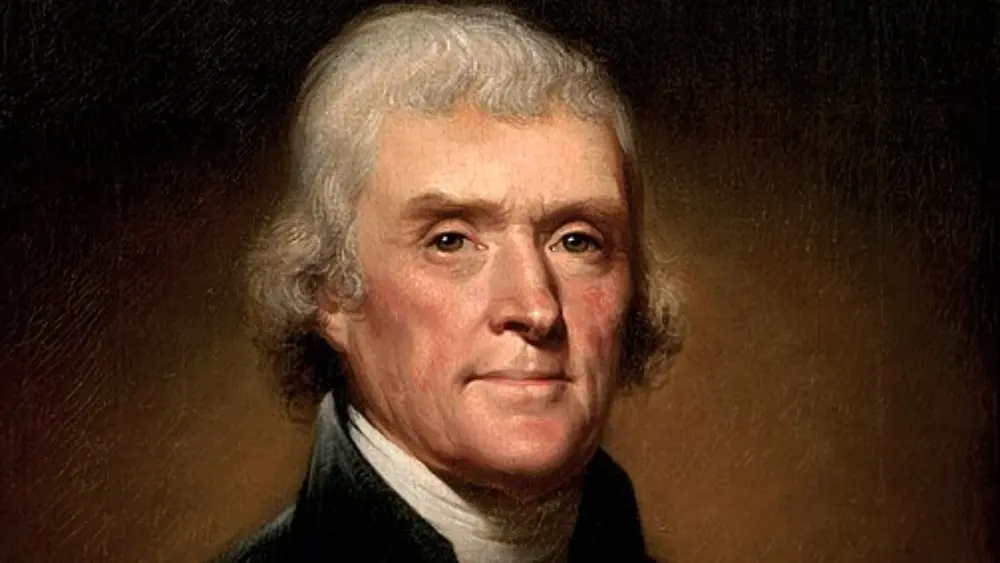Thomas Jefferson was a key figure in American history. He helped write the Declaration of Independence, which declared America’s freedom from British rule. Later, he served as the first secretary of state and then as vice president under John Adams. When he became the third president of the United States, he focused on stabilizing the economy and defending against pirates from North Africa during the Barbary War. One of his most significant achievements was the Louisiana Purchase, which doubled the size of the country. Jefferson’s impact extended beyond politics; he also founded the University of Virginia, leaving a lasting legacy in education.
Early Life
On April 13, 1743, Peter Jefferson and Jane Randolph welcomed their son Jefferson at the Shadwell plantation. Peter was a planter and surveyor, while Jane came from a prestigious Virginia family.
Sadly, when Jefferson turned 14, his father passed away, leaving him a sizable estate of 5,000 acres. He dreamt of living on a mountain, yet the inheritance included the Shadwell mansion.
Jefferson’s ideas and fight for human rights sparked the American Revolutionary War. This led to the foundation of the United States as a free country with its own Constitution and independence. He actively contributed to important papers and judgments at all levels, advocating for democracy, republicanism, and individual rights.
The Impact of Enslaved Labor on Jefferson’s Legacy
Moreover, his father and father-in-law, John Wayles, provided him with enslaved individuals, and he also bought and sold enslaved people. In a typical year, he had around 200 enslaved individuals, half of them under sixteen years old.
Approximately 80 of them lived at Monticello, while the rest resided on his Poplar Forest estate in Bedford County, Virginia, and nearby farms in Albemarle County.
Throughout his life, he owned over 600 enslaved people, who played a crucial role in managing his crops and maintaining his residence at Monticello. These men, women, and children worked in the fields and the main house and received training in various trades.
Childhood and Career
Albemarle County, where Jefferson was born, lay in the western province of the Old Dominion, nestled in the foothills of the Blue Ridge Mountains. His father, Peter Jefferson, a self-taught surveyor, owned a substantial estate with 60 enslaved people. Family history recounts Jefferson’s earliest memory as “being carried on a pillow by a mounted slave” when they moved from Shadwell to Tuckahoe when he was three.
After the passing of William Randolph III, a close friend of Peter Jefferson, who had named Peter the guardian of Randolph’s children in his will, the family moved to Tuckahoe Plantation in 1745. In 1752, they returned to Shadwell. Thomas found a close friend and early mentor in his uncle, Field Jefferson, after attending Field Jefferson and Mary Allen Hunt’s wedding in 1753.
Inheriting the Estate
When Peter Jefferson passed away in 1757, Thomas Jefferson and Randolph each received equal shares of their father’s fortune. John Harvie Sr. became Thomas’ 13-year-old guardian. At age 21, Thomas gained full legal control of the vast estate, including Monticello.
Thomas Jefferson on the Pursuit of Education
During the academic years of 1758–1760, Thomas studied history, physics, and the classics while living with the Reverend James Maury’s family in Gordonsville, Virginia. On their journey to Williamsburg for commerce, he befriended and got to know several Native Americans, including Cherokee leader Ostenaco.
Williamsburg and Early Acquaintances
For two years while staying with the Maury family, Jefferson visited Williamsburg, where he was a guest of Colonel John Dandridge, Martha Washington’s father. In Williamsburg, he met Patrick Henry, who shared his passion for violin playing.
Pursuit of Knowledge and Career
During his first year of college, Jefferson enjoyed parties and dancing but was not frugal with spending. In his second year, he committed to studying fifteen hours per day, enhancing his knowledge of French. He also knows how to speak Greek and play the violin. In 1762, he received his degree. He worked as a law clerk under Wythe’s guidance to become a lawyer and read a wide range of political writings, including English classics.
Thomas Jefferson and His Early Political Writing
Jefferson spent five years reading law under the guidance of George Wythe, a well-known jurist in Virginia. At the age of seventeen, he began a two-year course at the College of William & Mary. One of his earliest political writings, the “Summary View of the Rights of British America,” gained widespread praise in 1774. It was a draft of instructions for Virginia’s delegation to the First Continental Congress.

From Unity to Independence
In the “Summary View,” Jefferson said Virginia didn’t want separation from the mother country. However, just two years later, as a member of the Second Continental Congress and the appointed drafter of the Declaration of Independence, he passionately advocated for the colonies’ claim to be free and independent states. The Declaration of Independence is seen as a charter for both American and global freedoms.
Principles of the Declaration
The Declaration of Independence proclaims that all men are equal in rights, regardless of their birth, wealth, or social status. These rights are seen as inherent in every individual, bestowed by God and not by the government. Furthermore, it emphasizes that the role of the government is to serve the people, not to dominate them.
The Death of Thomas Jefferson
Despite his debts, Thomas Jefferson remained upbeat about the Republican experiment’s future. He passed away on July 4, 1826, just hours before his friend John Adams, the day after the 50th anniversary of the Declaration of Independence. He had declined to attend the celebration in Washington ten days before his passing. But he had assured that “all eyes are opened, or opening, to the rights of man.










